Introduction to Coral Bells
The genus Heuchera (coral bells), and its intergeneric hybrid x heucherella (foamy bells), are enchanting woodland plants, grown primarily for their evergreen foliage. Although, many also offer a charming floral display as well. In the last 15 years, an enormous number of new cultivars have been developed and made available to gardeners. Breeders have made astonishing breakthroughs in leaf color, flower longevity, and flower size. We have trialed a large number of these and offer what we think are the best performers for the hot, humid, southeast US. 
Heuchera 'Paris' PP 18,881
How to Grow Heuchera and x Heucherella
How long do Heuchera live?
The only downside to Heuchera is that they are short-lived, unless they are divided every 3-4 years as the crown becomes woody. Unlike hosta and good wine, heucheras do not get better with age.
What type of soil is best?
They like an open, well-aerated soil that has good drainage. Heucheras prefer neutral pH soils and while they will grow fine in slightly acid soils, they will not fair well in extremely acid soils. What Heuchera also will not tolerate is heavy soil combined with winter moisture...both sure killers. A raised bed is best because it will keep the soil well drained and improve air circulation.
How much sun and wind exposure should heucheras receive?
A light open woodland or light shade to part sun spot is perfect. In North Carolina, a site with 3 to 5 hours of dappled sunlight per day is perfect. Some Heuchera can tolerate full sun, especially in northern states as long as the soil doesn't remain bone dry for too long. Good air movement is important to keep down fungal diseases.
Heuchera 'Cajun Fire' PP 24,150
What about mulch?
Northern gardeners have found that a layer of winter mulch helps protect the Heuchera crowns in the colder end of their range.
How heat and humidity tolerant are heuchera?
Hybrid Heuchera have a wide variability of cold tolerance and heat/humidity tolerance. Eastern species are more heat and humidity tolerant than western ones. Cultivars with Heuchera micrantha heritage are not as cold or heat tolerant as Heuchera villosa and Heuchera richarsonii offspring. The western species tend to melt in the summer heat and humidity of the south but Heuchera villosa, Heuchera americana, and Heuchera pubescens perform very well in humid gardens. The hybrid x Heucherella are generally less heat and cold tolerant than either parent.
How much water?
Heuchera and x Heucherella both have good drought tolerance. During the growing season, 1" of water per week will keep your heuchera happy. Less during winter to avoid winter root rot.
How to Propagate Heuchera and x Heucherella
Commercially, all Heuchera and x Heucherella are produced in tissue culture but are easy for the home gardener to propagate. Be aware that is it illegal to asexually propagate any patented plant (by divisions or cuttings) and that almost all Heuchera and x Heucherella on the market today are patented. It is ok to grow plants from the seed of patented plants, however.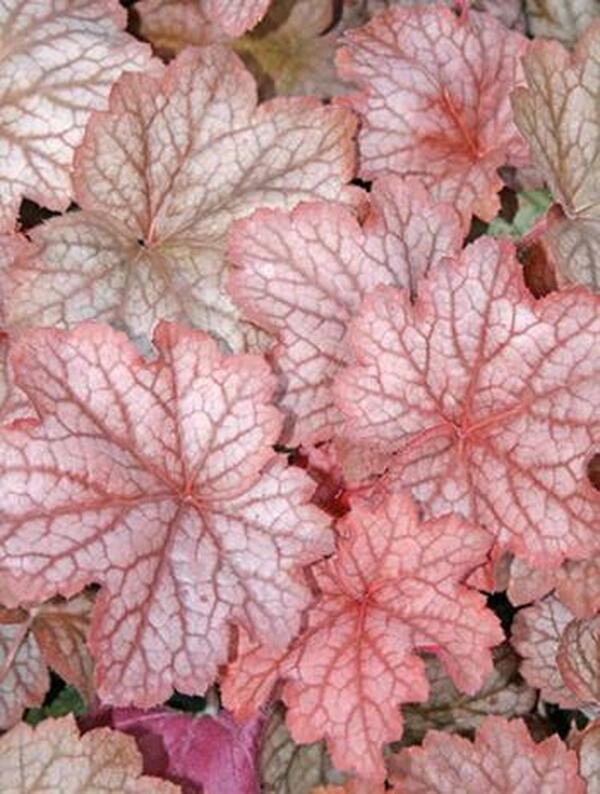
Heuchera 'Georgia Peach' PP 19,375
Heuchera are generally self-sterile and so gardeners who want seed will need to plant more than one species or cultivar. The flowers appear in the summer and the seeds will be ready six weeks after pollination when the seed pods turn brown and split open. The seed can be collected and sown immediately. Germination will occur in 30 days and the seedlings will be ready to pot up by fall.
In addition, Heuchera and x Heucherella can be divided. Dig up the three-year-old clumps and pull the rooted offsets apart. The smaller offsets may need to be potted, then replanted in a well-prepared bed. I have done this in both summer and winter with good success. The offsets can also be treated like a stem cutting, and will root easily without any rooting hormone as long as they are protected from desiccation during the rooting process. With a little more care, gardeners may also have success by removing a leaf at the base along with a small piece of stem tissue and rooting the leaf/stem cutting.
Pests and Diseases
The astringent (bad tasting) Heuchera and tiarella leaves are generally left alone by deer and rabbits. This makes them a great substitute for hosta where the deer pressure is high. Just remember that, in the middle of winter a ravenous deer or rapacious rabbit will eat anything, including a heuchera.
Heuchera and x Heucherella are generally not affected by insect pests in the garden. However, Heuchera may occasionally be pestered by black vine weevils (especially in the Pacific Northwest) which bore into the crown and kill the tops. Untreated, they will eventually kill the plant but black vine weevils can be controlled by systemic insecticides. Rarely, foliar nematodes will cause ugly discolored patches on the leaf and there is no control for nematodes ... avoidance is the key. Buy plants only from nurseries that scout for and remove infected plants.
In hot humid gardens, some cultivars will experience summer dieback due to the fungus sclerotinia. Gardeners should select cultivars that are known to be tough for their area. Good air circulation is the most important preventative measure, so be sure to keep other plants from overgrowing your heuchera.
How to Grow Heuchera and x Heucherella in a Container
Heuchera and x Heucherella are superb in mixed containers, where they prefer well-drained potting mixes without a lot of fertilizer. Keep the pots well watered in the summer but do not over-water in the winter. The pots will need some protection from cold winter temperatures if the container are not insulated. The foliage that these plants provide and their well-behaved growth habit make them ideal for creating stunning combinations.
Landscape Uses
The attractive foliage of Heuchera and x Heucherella is very valuable to garden designers because it provides a season-long splash of color. Colorful foliage is much more valuable in garden design than flower color because flowers are often short-lived. However, Heuchera flowers should not be discounted because they bring an open, airy, informal flavor to the garden during part of the growing season. And if deadheaded, the flower show lasts quite a long time. Gardeners can reliably count on a full season of purple, bronze, chartreuse, or silver foliage color in their garden when they incorporate heuchera. Designers can use Heuchera in partial shade locations in the same way that they use hosta. Heuchera provide the same rosette growth habit as a small or medium-sized hosta with a larger array of foliage and flower colors. In addition, Heuchera are deer-resistant and can be used as a substitute for hosta in gardens that are being dashed by Dancer and blitzed by Blitzen.
Some good companions for Heuchera and x Heucherella include carex, ferns, hosta, and epimedium. Group the purple-leaved heuchera cultivars with other purple plants such as Japanese maple or purple smoke tree (Cotinus coggygria) to create a purple and silver haven. Contrast the purple-leaved cultivars with complimentary colored foliaged or flowering plants such as yellow (Lysimachia 'Aurea'), pink (Lychnis) or white (Aloysia virgata). Similarly, pair the trees and shrubs listed above with yellow- or bronze-leaved Heuchera to create a contrasting color palette. Use the silver-leaved cultivars with other silver or white plants in a formal garden or in a night garden. They look great with white-flowered Hydrangea 'Annabelle', Phlox 'David', and moon vine. Create a riot of hot colors by using the red-, pink-, or bronze-leaved cultivars with other hot colors like red, orange, and yellow.
History and Background
Heuchera goes by the common names "coral bells" and "alum root". The former name refers to the red flowers seen on the popular garden species Heuchera sanguinea. The latter name refers to the fact that the tannin-rich, astringent roots can be used like alum in the pickling process. The roots are also used as medicine to shrink tissues in those with nose bleeds, sore throats, ulcers, and piles. Heuchera is closely related to tiarella (foam flower), and the two genera have been crossed to create the intergeneric hybrid x heucherella, to which we give the common name "foamy bells". Coral bells and foamy bells have become very popular with native plant enthusiasts because they are attractive and easy to grow.
Heuchera are native to North America from Florida west to California and north into southern Canada. They are generally found in woodland or mountainous (montane) environments growing primarily in crevices or on well-drained steep slopes. That being said, I have seen heucheras in the wild on steep outcrops in Tennessee and also in wet seeps in the agave-laden deserts of Arizona, so they can tolerate a range of conditions.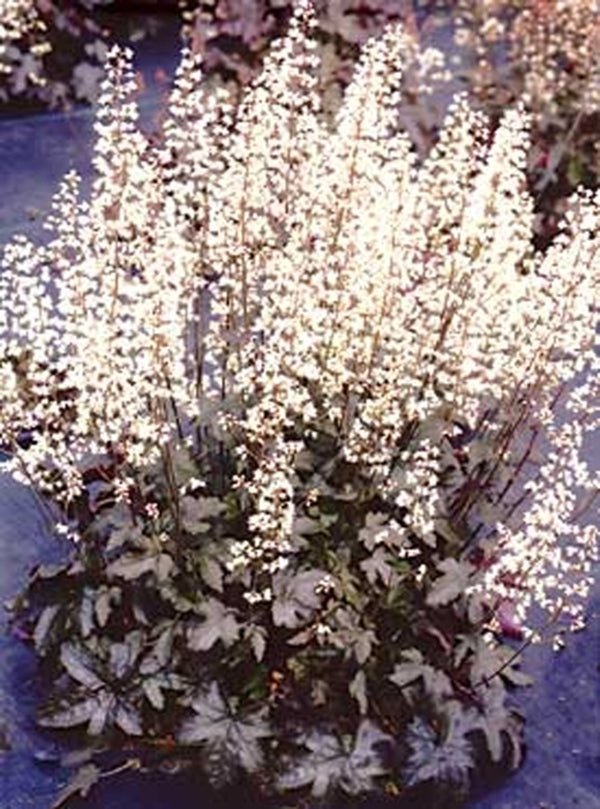
Heucherella 'Birthday Cake' PP 16,158
Morphology
Heuchera is an herbaceous shade perennial that grows as clumps of leaves arising from a central crown held at, or just below, the soil surface. The crown is a short central stem (a caudex) with leaves arranged in a congested spiral with 6 leaves arising from the stem for each complete turn of the spiral. Each node also contains a bud that will eventually form a new leaf or an inflorescence. The primary ornamental feature of Heuchera is the leaf color. In the wild, the leaves are usually green with occasional contrasting purple veins and silver or white interveinal patches. During the winter they may take on bronze or purple hues. Hybrid cultivars have a wide range of bright colors including vibrant red, yellow, orange, bronze, pink, and purple, often with an interveinal silver-white pattern too.
Heuchera "flowers" are actually inflorescences; a collection of many small bell-shaped, or spidery "florets" on a single floral structure. The flower stalk (peduncle) stretches 2 to 3 times the height of the canopy. Heuchera flowering stalks are highly branched (up to 30 branches) and each branch holds a dozen or so small colorful florets that vary in color, including greenish-white, white, pink, coral, crimson, scarlet, and red.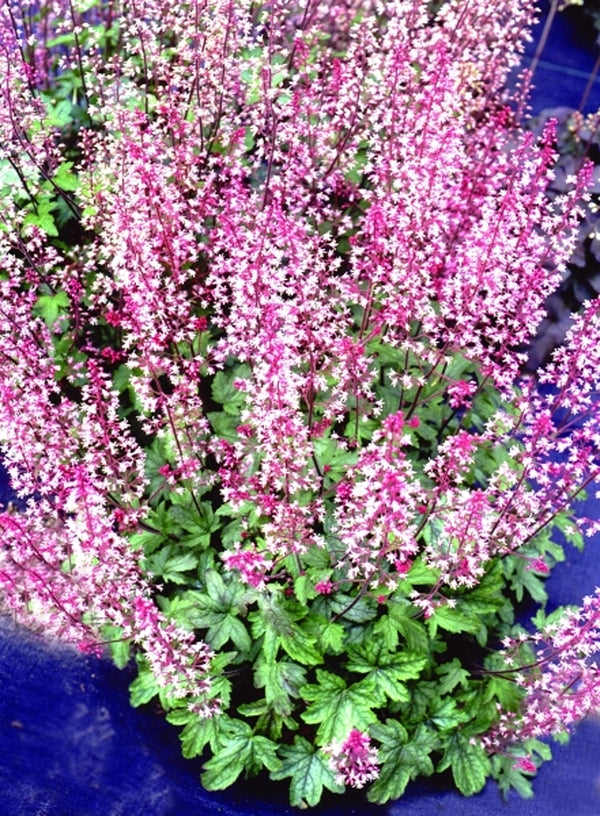
Heucherella 'Party Time' PP 16,181
Taxonomy
The genus Heuchera consists of 35 to 50 species (depending on who you ask) that are all native to North America. There are 7 primary species east of the Mississippi river, more than 27 species that are endemic to the West, and at least one species is native to the Midwest. However, there is some conflict as to the exact species designations because the species interbreed with each other where their habits overlap resulting in many intermediate forms. The genus Heuchera was named by Carl Linnaeus for the botanist and medicinal plant expert Johann Heinrich von Heucher (1677-1747) of Wittenberg University in Germany. If you want to pronounce Heuchera after its namesake, use "HOY-kher-uh" with a guttural 'kh' sound that has no English equivalent. However, most Americans pronounce the name as "HYOO-ker-uh"....I say, HYOO CARES!
Heuchera belongs to the family Saxifragaceae which contains other ornamental plants such astilbe, astilboides, bergenia, mukdenia, saxifraga, rodgersia, and tiarella. The name Saxifragaceae comes from the Latin saxum meaning "rock" and frangere meaning "break". Plants in this family are often seen growing in cracks and crevices of stony places and their roots are thought to contribute to the erosion and breakdown of rocks. The genera Heuchera and tiarella are very closely related and have been artificially crossed to create the intergeneric hybrid genus x heucherella.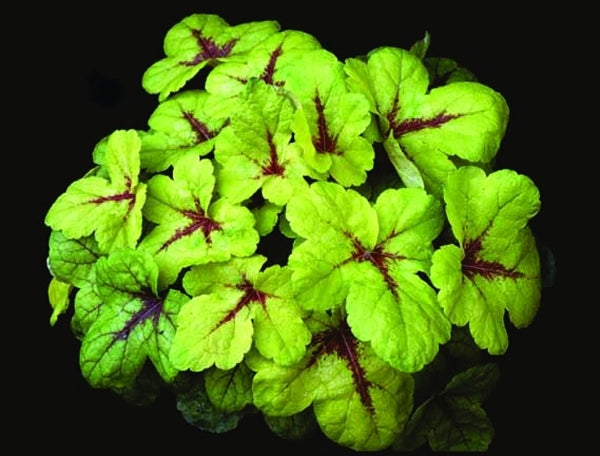
Heucherella 'Sunspot' PP 14,825
Heuchera and x Heucherella Breeding Programs
Heuchera americana was discovered by the first American colonists and brought into European gardens in the 1600s. By the 1800s European gardeners were also growing Heuchera richardsonii, Heuchera cylindrica, and Heuchera villosa. As is so often the case, the first breeders of this native American gem in the late 19th and early 20th century were Europeans. Among the earliest breeders was Emile Lemoine of France who was active from the 1890s until World War I. He primarily worked with crosses of Heuchera sanguinea and Heuchera americana. 
Heuchera 'Amber Waves' PP 13,348
Alan Bloom of Blooms of Bressingham Nursery in England was actively breeding plants from the 1930s to the 1990s and focused on creating cut-flower hybrids, for which he used Heuchera micrantha, Heuchera americana and Heuchera sanguinea. Also in the 1930s, an American, C. O. Rosendahl, at the University of Minnesota was creating hybrid crosses between Heuchera sanguinea and Heuchera richardsonii to combine red flower color and cold tolerance.
The majority of the early hybrids were collectively known as Heuchera x brizoides. This group includes hybrids using Heuchera americana, Heuchera bracteata, Heuchera cylindrica, Heuchera micrantha and Heuchera sanguinea. Heuchera x brizoides cultivars all have bell shaped flowers of white, pink or (most commonly) red and leaves with a varying amount of silver on the face. Modern breeders often use members of this group as parents in their own programs. Commercially, Heuchera x brizoides has been replaced by improved modern hybrids but some still live on in collections and as a parent group for modern breeding programs.
Each Heuchera species contributes valuable ornamental traits to the mix such as plant size, leaf color, flower color, heat/humidity tolerance or cold tolerance. Heuchera maxima has large open flowers and is drought tolerant, Heuchera sanguinea has red flowers and is tall. Heuchera alba has large tubular white flowers and is a small plant. Heuchera pilosissima has small pink flowers and is drought tolerant. Heuchera pubescens has strong silver patterning in the leaves and large bell-shaped flowers. Heuchera micrantha has been used as a source of ruffled leaves and purple/bronze leaf color. It is also small plant with bell-shaped flowers. Heuchera villosa is a large plant, is very tolerant of heat and humidity, has bell-shaped flowers and also has some bronze or purple leaf color. Heuchera americana is a large plant, is shade tolerant, mildew resistant, has silver markings on the leaf face, and is very heat tolerant.Heuchera cylindrica is a large plant that makes its offspring taller and wider.
In the 1950s, Lee Lenz of the Rancho Santa Ana Botanic Garden in Claremont California started hybridizing Heuchera maxima (a large species from the Santa Barbara Channel Islands) with Heuchera sanguinea to create hybrids for the southern California market. These large, colorfully flowered hybrids are known as the "Rancho Santa Ana hybrids". They are very drought tolerant but not very cold hardy. In the 1980s Dara Emory of the Santa Barbara Botanic Garden used small montane species native to California (Heuchera hirsutissima, Heuchera merriamii) crossed with Heuchera sanguinea to create the "Canyon hybrids" which are small and have intense flower color. The breeding work at Santa Ana Botanic Garden continues today, led by Bart O'Brien.
The first big break through in purple foliaged Heuchera was Heuchera 'Palace Purple'. It was discovered by Brian Halliwell in 1980 in a seed lot growing at the Royal Botanic Gardens, Kew near Kew Palace. Although popular, many of its seed-propagated offspring have an inferior purple color. The original plant was awarded with the 1991 Perennial Plant Association "Plant of the Year" award and with a prestigious Award of Garden Merit (AGM) from the Royal Horticultural Society. Although the cultivar 'Palace Purple' was initially given the scientific name Heuchera micrantha var. diversifolia, it turned out there was a tag reading error. The original seed was collected from a naturally occurring purple-leaved plant by Edgar Wherry in the southern United States, where Heuchera micrantha is not native. It was later determined to be the southeast US native Heuchera villosa var. macrorrhiza.
Since the 1980s, breeders and collectors have been selecting other purple-leaved strains that are superior to 'Palace Purple'. Most of the modern purple-leaved hybrids come from a parent that originated from a cross between 'Palace Purple' and a purple and silver-leaved seed strain of Heuchera americana called Dale's Strain. This cross, which occurred at North Carolina's former Montrose Nursery, created a superior purple-leaved hybrid strain named by nursery owner Nancy Goodwin as Heuchera 'Montrose Ruby'. Heuchera 'Montrose Ruby' was passed around to many breeders who have used it as a parent to create the wonderful colored-leaf forms we see today.
Modern breeders have been very busy releasing well over 200 cultivars (as of 2009) of Heuchera and x Heucherella in a short time. These new perennials display never-before-seen foliage colors and flower combinations.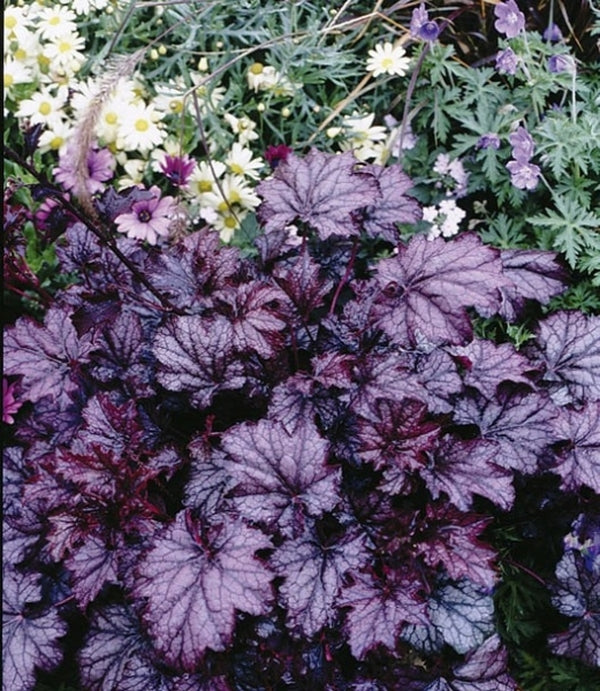
Heuchera 'Amethyst Mist'
Arguably the most prolific modern Heuchera breeder is Dan Heims, owner of Terra Nova Nurseries in Oregon. He has been instrumental in collecting unusual sports and color breaks from plants in his tissue culture program. He has released heucheras with incredible breakthroughs in foliage color including silver, gold, orange, and chocolate. Terra Nova's program began with its first patented Heuchera in 1993, Heuchera 'Chocolate Ruffles' PP 8965, and then exploded into a dizzying array of cultivars with seemingly every trait imaginable.
Most recently, the Terra Nova folks have created new x Heucherella cultivars and as of 2009, have released at least 14. Among their best are the yellow-leaved sports 'Stoplight' and 'Sunspot' that arose in their tissue culture program. Dan Heims's Heuchera breeding program is quite large, with as many as 10,000 crosses made every year.
Charles and Martha Oliver of The Primrose Path Nursery in Pennsylvania started breeding Heuchera in the 1980s using Heuchera x brizoides as well as Heuchera americana, Heuchera cylindrica, Heuchera pubescens, Heuchera hallii, and Heuchera pulchella. Their first patented Heuchera was Heuchera 'Petite Pearl Fairy' PP 11,058 in 1998. They have released 39 Heuchera and nine x Heucherella to the general market over the years, but the most horticulturally important is Heuchera 'Frosted Violet' PP 15,085 in 2002, one of the first Heuchera villosa hybrids.
Thierry (pronounced Cherry) Delabroye is a breeder in northern France who has a small collector's nursery. He has released 12 cultivars of Heuchera since 2005, based on Heuchera villosa. Resulting in hybrids that have proven to be much more tolerant of hot, humid conditions. Since his 2004 introduction of Heuchera 'Caramel' PP 16,560. Thierry has focused on bronze and red colored leaves, but also selected the chartreuse cultivar 'Citronelle' from his tissue cultured specimens.
One of the most interesting breeding breakthroughs has been the intergeneric crossing of Heuchera with Tiarella to create x Heucherella. The original cross was made by Emile Lemoine in France in 1912. Alan Bloom made the same crosses in the 1950s that resulted in some commercial releases and Tony Huber did the same in 1983. Crossing Heuchera with tiarella creates plants with traits that are intermediate to both parents. The leaves are usually deeply lobed and have a central maroon marking like tiarella. The Heuchera parent provides a range of leaf colors including bronze, yellow and silver to the offspring. Although tiarella normally spreads by runners, this trait is moderated in x heucherella. This intergeneric cross does not produce very many seed. The cross works best if the seed parent (momma) is a heuchera. All x Heucherella are sterile and thus cannot be used in further breeding efforts.
Heuchera Species, Groups, and Cultivar List
Today, there are hundreds of Heuchera and x Heucherella cultivars on the market. Below is a list of many interesting and historical cultivars. At Plant Delights Nursery and Juniper Level Botanic Gardens, we strive to try all of the new cultivars for their tolerance to our hot, humid Hardiness Zone 7b climate.
Heuchera americana 'Bartram' (Bartram Coral Bells)
This is a fabulous older selection of Heuchera americana from the garden of plant explorer John Bartram (of Franklinia fame) in Pennsylvania. Heuchera 'Bartrum' has the typical dark green foliage on a 1' tall x 18" wide clump, overlain with striking dark red veins fading into the leaf center...some silver blotching at maturity. This one is unique in the ever expanding world of heuchera. (Hardiness Zone 4-9)
Heuchera americana 'Dale's Strain' (Dale's Strain Coral Bells)
This seed strain was found in North Carolina, propagated by Dale Hendricks, founder of North Creek Nursery in Pennsylvania, and consequently sold around the world. The leaves are green with white, red, and a network of different color veins on a 1' tall x 18" wide clump. Heuchera 'Dale's Strain' is a very vigorous coral bells, great for naturalizing in wooded areas. (Hardiness Zone 4-9)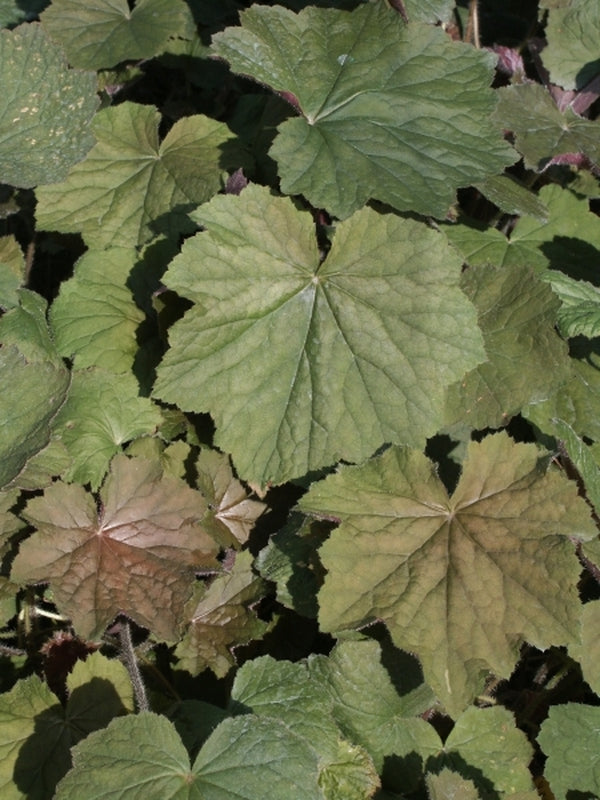
Heuchera 'Brownies' PPAF
Heuchera americana 'Eco-magnififolia' (Eco Magnififolia Coral Bells)
From Weaverville, NC comes this dazzling Don Jacobs selection of Heuchera americana ssp. heteradinia. The 1' tall x 18" wide clump feature foliage with a stunning silver overlay with green veins and a green edge. The leaf veins change to brilliant purple in cool weather, providing an even more incredible contrast. Each Heuchera makes a 18" wide clump, perfect for the woodlands garden. (Hardiness Zone 4-9)
Heuchera americana 'Garnet' (Garnet Coral Bells)
This is one of the most famous Heuchera americana selections, from Dick Lighty, retired director of Pennsylvania's Mt. Cuba Center. Each 1' tall x 18" wide clump of Heuchera 'Garnet' has green leaves until cool weather, when the entire center of the leaf turns a brilliant garnet red with a striking green edge. This coral bells is a real eye catcher in the woodland garden. (Hardiness Zone 4-9)
Heuchera 'Blackout' PP 20,613 (Blackout Coral Bells)
Heuchera 'Blackout' from Belgium's Dirk Scheys is the blackest of the coral bells. The glossy jet black leaf with a purple underside forms a vigorous but compact clump to 1' tall by 18" wide. In the garden it should be blended with gold foliage plants and light airy textures for best effect. The clumps are topped with spikes of small white flowers in spring. (Hardiness Zone 4-7)
Heuchera 'Caramel' PP 16,560
Heuchera 'Brownies' PPAF (Brownies Coral Bells)
Heuchera 'Brownies' is another superb coral bells from French breeder Thierry Delabroye. Just like its sister seedling, Heuchera ‘Caramel’ , Heuchera 'Brownies' contains genes from the heat-loving Heuchera villosa, along with a number of other species. Heuchera 'Brownies' contains will make a vigorous clump to 1' tall by 2'+ wide. The clump is adorned with hairy olive-brown leaves. Heck, it's not just the leaves that are hairy, the stems are hairy, the flower stalks are hairy...hang on a minute, and I'll check the roots. The plants are topped in summer with tall spikes of small white flowers. (Hardiness Zone 4-8)
Heuchera 'Caramel' PP 16,560 (Caramel Coral Bells)
I first saw the handiwork of French breeder Thierry Delabroye on a trip to Holland. I returned home with a plant of Heuchera ‘Caramel’, and I planted it beside other coral bells that were on trial. By the end of the summer (more than 100 days over 86 degrees F), most of the coral bells were dead. However, Heuchera ‘Caramel’ loved the weather. The reason is the use of the heat-loving Heuchera villosa in the breeding line. The 1' tall by 2' wide hairy clumps emerge with butterscotch foliage which changes to peachy-orange as the season progresses. These sun-tolerant plants are topped in summer with tall spikes of small white flowers. (Hardiness Zone 4-8)
Heuchera 'Citronelle' PP 17,934
Heuchera 'Chocolate Ruffles' PP 8965 (Chocolate Ruffles Coral Bells)
This hard-to-find Heims Heuchera is a real color breakthrough. The leaves are a deep chocolate brown, with vivid purple undersides...yes, I looked! The leaves are deeply cut and heavily ruffled on the edges. The 2' wide clumps are topped with 2' tall scapes of insignificant flowers during summer. (Hardiness Zone 4-8)
Heuchera 'Citronelle' PP 17,934 (Citronelle Coral Bells)
If you like the yellow-leaf coral bells but they haven't proven to be heat tolerant in your climate, your solution is here. From France's Thierry Delabroye comes Heuchera ‘Citronelle’, a gold leaf mutation from his wonderful Heuchera villosa hybrid, Heuchera ‘Caramel’. Like its parent, Citronelle Coral Bells makes a 1' tall by 18" wide clump of golden foliage, topped in summer with tall spikes of small white flowers. Heuchera ‘Citronelle’ doesn't seem to enjoy full sun like most of its siblings ... must be a blonde thing. (Hardiness Zone 4-8)
Heuchera 'Creme Brulee' (Creme Brulee Coral Bells)
This Terra Nova introduction has indeed been quite surprising for its sun and heat tolerance. The 12" tall by 18" wide, robust clumps are composed of peachy-orange leaves that brighten as the season progresses. In late June, the clumps are topped with 22" tall, dark red flower scapes, lined with tiny, creamy yellow flowers. Heuchera 'Creme Brulee' opens the door for some really cool color combos in the garden...superb! (Hardiness Zone 4-8a)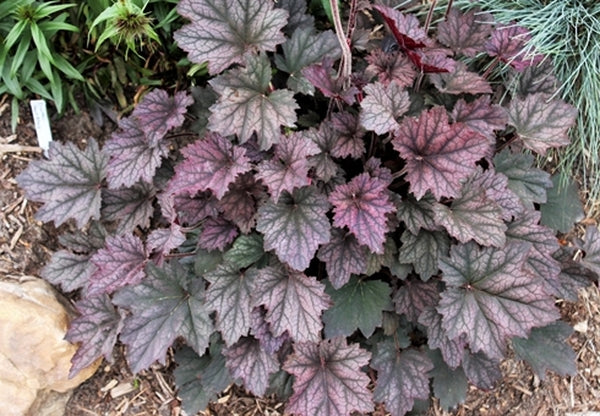
Heuchera 'Frosted Violet' PP 15,085
Heuchera 'Crimson Curls' PP 13,729 (Crimson Curls Coral Bells)
From England's Ray Brown comes a stunner with incredibly ruffled foliage...even the ruffles are ruffled. The dark burgundy-red leaves are purple underneath and radiate out to form a perfect 18" wide evergreen clump. (Hardiness Zone 3-8a)
Heuchera 'Frosted Violet' PP 15,085 (Frosted Violet Coral Bells)
From the great breeding work of Charles Oliver comes a vigorous new coral bells, thanks to the inclusion of our native Heuchera villosa in the parentage. The attractive, pink-purple foliage with darker veining adorns the huge 2'+ wide clump. In late spring, the clumps are topped with 30" flower spikes of small, light pink flowers. This is a real winner...especially for East Coast gardeners. (Hardiness Zone 4-8a)
Heuchera 'Georgia Peach' PP 19,375 (Georgia Peach Coral Bells)
Heuchera 'Georgia Peach' is the newest coral bells hybrid containing the heat-loving Heuchera villosa. We were particularly impressed at how well they looked after our 3 weeks above 100 degrees F. This vigorous Terra Nova introduction makes a 14" tall x 2' wide clump of large peachy-red leaves, each highlighted by darker red veining. The 14" tall clumps are topped in late summer with 30" spikes of small white flowers. Although Heuchera villosa hybrids are much more tolerant to adverse growing conditions, we still recommend a well-drained soil. (Hardiness Zone 4-8)
Heuchera villosa 'Bressingham Bronze' (Bressingham Bronze Coral Bells)
From England's Blooms of Bressingham, comes Heuchera 'Bressingham Bronze' ...a selected seedling from for exceptional color and vigor. The vivid purple evergreen foliage holds year round. In early summer the clumps are topped with tiny white flowers. (Hardiness Zone 4-8)
Heuchera 'Montrose Ruby' (Montrose Ruby Coral Bells)
This fabulous Heuchera seed strain came from the former Montrose Nursery in Hillsborough NC. Heuchera 'Montrose Ruby' is a cross between Heuchera 'Palace Purple' and Heuchera Americana 'Dales Strain', and is the parent of many of the Terra Nova hybrid heuchera. The 18" wide x 15" tall clumps are adorned with dark purple leaves with a unique silver marbling. (Hardiness Zone 4-9)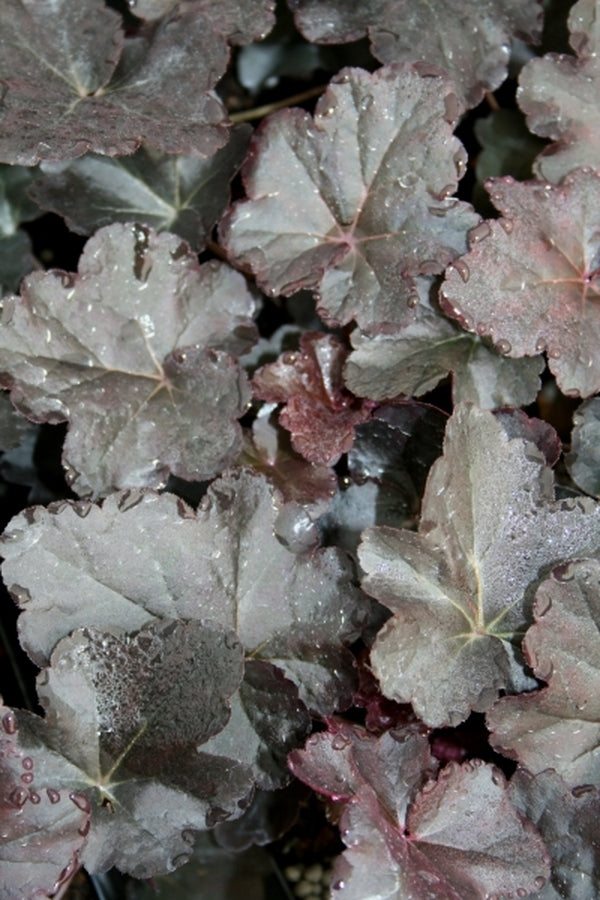
Heuchera 'Obsidian' PP 14,836
Heuchera 'Obsidian' PP 14,836 (Obsidian Coral Bells)
This Terra Nova introduction boasts glossy black-purple leaves that form a 10" tall by 16" wide clump. In late spring, the clumps are topped with 2' tall spikes of insignificant whitish flowers...grow this one for the foliage. (Hardiness Zone 5-7)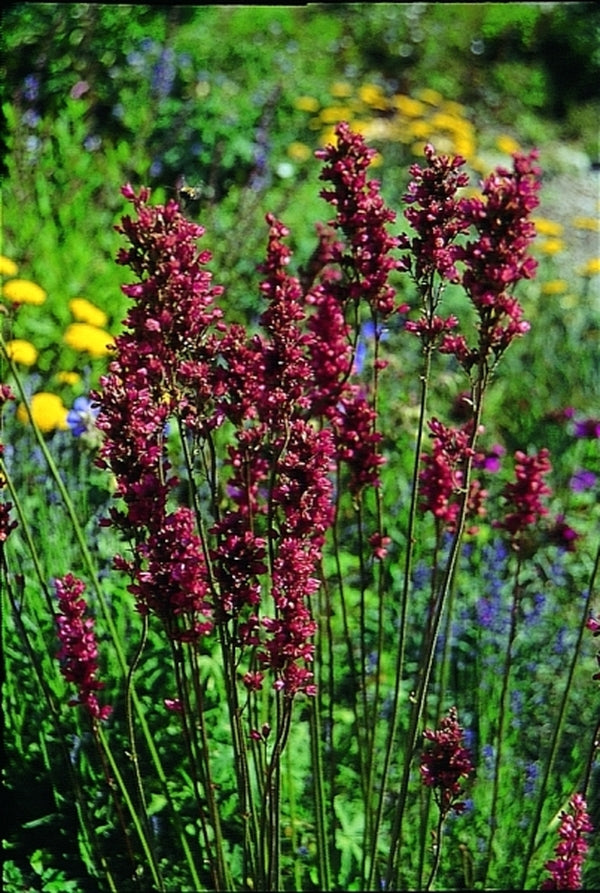
Heuchera 'Raspberry Regal'
Heuchera 'Paris' PP 18,881 (Paris Coral Bells)
This Terra Nova introduction makes a small 9" tall by 15" wide clump of silvery leaves, highlighted with dark green veins. The clumps are topped from mid-April through early July with 15" tall sturdy spikes of small rosy-red flowers. This is unquestionably the best flowering coral bells we've ever trialed. As with all coral bells, we recommend a well-drained garden site as well as dividing them every 2-3 years. (Hardiness Zone 4-8)
Heuchera 'Petite Pearl Fairy' PP 11,058 (Petite Pearl Fairy Coral Bells)
Darn, they are cute...how cute, you ask...cuter than a two legged baby at a grandmothers convention. This new series of tiny dwarf coral bells are best "babied" in a rock garden or small, special, well drained site. The tiny rounded leaves of purple w/silver veins make a perfect 6" wide x 10" clump. In early summer, the clumps are topped with 12" spikes of medium pink flowers. Plants in the "petite series" have no tolerance of heat and humidity. (Hardiness Zone 4-7)
Heuchera 'Purple Petticoats' (Purple Petticoats Coral Bells)
The solid dark purple leaves have intensely ruffled edges on a 1' tall x 16" wide clump...simply dramatic! As on most Heuchera americana hybrids, the flowers are insignificant. (Hardiness Zone 4-9)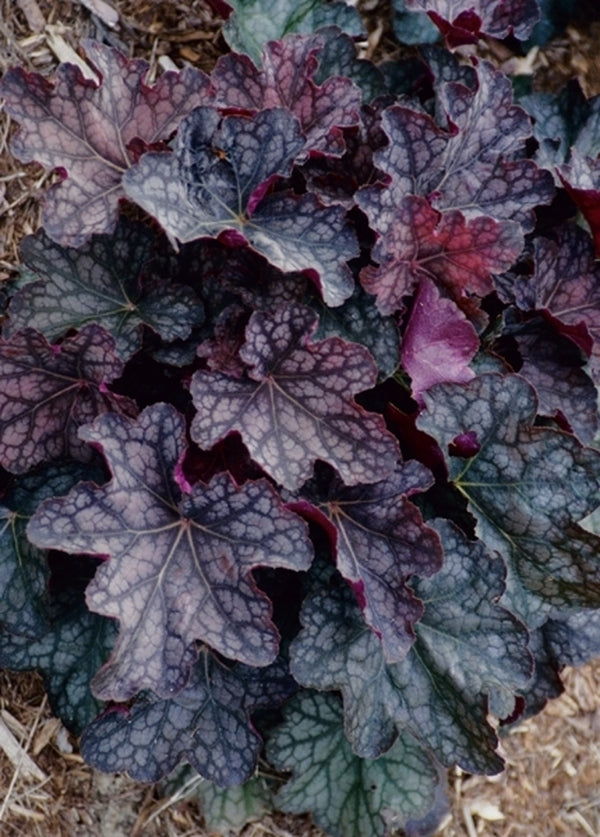
Heuchera 'Velvet Knight'
Heuchera 'Raspberry Regal' (Raspberry Regal Coral Bells)
From Busse Gardens of Minnesota came this vigorous growing rosette of scalloped light green foliage with silver markings. From the 1' tall x 18" wide clumps arise giant 36" spikes of large raspberry red flowers in late spring and early summer that are nothing short of fabulous! Not only is Heuchera 'Raspberry Regal' great in the garden, but it'll even make a cut flower arranger out of those of us with no artistic ability! Unfortunately, it is not a good choice for the southeast US. (Hardiness Zone 3-9)
Heuchera 'Southern Comfort' PP 20,364 (Southern Comfort Coral Bells)
Heuchera 'Southern Comfort' is the Terra Nova equivalent to Heuchera ‘Caramel’.
Heuchera 'Southern Comfort'The vigorous growing 14" tall by 2' wide evergreen clumps produce an abundance of amber-colored leaves that emerge peachy-orange. As the night temperatures cool, the entire plant takes on a coral-orange hue. This is one of those dramatic coral bells all of our visitors notice. The Heuchera villosa parentage gives amazing vigor, as well as good sun and soil moisture tolerance. (Hardiness Zone 4-8)
Heuchera 'Tiramisu' PP 20,429 (Tiramisu Coral Bells)
Heuchera 'Tiramisu' is another great Heuchera villosa hybrid from Thierry Delabroye's breeding program. The 1' tall x 18" wide clumps of amber/chartreuse foliage begin showing red veins as the night temperatures begin to cool in fall. When the 1' tall by 18" wide evergreen clumps begin to expand in early spring, the leaf veins become so bright with red, the leaves appear to be red with a golden border. (Hardiness Zone 4-8)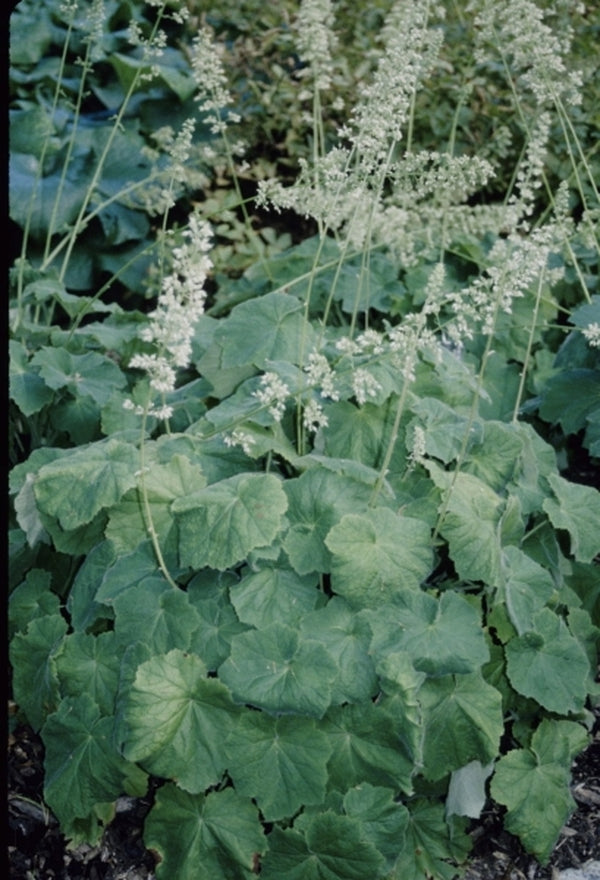
Heuchera villosa var. arkansana
Heuchera 'Velvet Knight' (Velvet Knight Coral Bells)
The foliage on this Dan Heims selection is dark purple with red veining, giving the appearance of crushed velvet overlay...I don't know how he did it! Heuchera 'Velvet Knight' is striking near blue-foliaged hostas. When established, the 1' tall x 18" wide clump will have 7" wide leaves! (Hardiness Zone 4-9)
Heuchera villosa (Hairy Coral Bells)
This NC native coral bells is a giant compared with many of the others. In addition to its size, 2' by 2', Heuchera villosa offers incredible soft fuzzy leaves with a velvety texture...the kind you just have to squeeze. In late summer, this gorgeous native produces stalks of tiny creamy white flowers from September thru October...truly an overlooked wonderful native! (Hardiness Zone 4-9)
Heuchera villosa 'Bronze Wave' (Bronze Wave Hairy Coral Bells)
This 2001 Primrose Path introduction is a superb selection of the US native (New York south to Alabama), Heuchera villosa f. purpurea. Each massive 18" tall by 2' wide clump is composed of very hairy, large, 8" wide, dark bronze leaves with a contrasting purple back. In late summer, the 2' tall flower spikes are laden with small whitish-pink flowers. This is not a seed strain, as has been the case in the past with most purple leaf forms of Heuchera villosa. (Hardiness Zone 4-8)
Heuchera villosa var. arkansana (Arkansas Hairy Coral Bells)
This rare Arkansas endemic is a form of the more widespread native Heuchera villosa var. villosa, which ranges from New York to the Mississippi River. This form of the durable, evergreen Heuchera villosa is not only tolerant of heat and humidity, but is purportedly much more hairy than normal...come to think of it, so are many of the people I know from the same region. This variety is only native to a narrow section of the Ozarks, where it can be spotted in rocky woods or hanging from sandstone cliffs. Our offerings are seed grown from a Newton County population. The large, hairy green, maple-shaped leaves form a large 18" tall x 2' wide clump. From August until fall, the clumps are topped with airy 3' tall stalks of small white flowers. (Hardiness Zone 4-8)
x Heucherella Cultivars
x Heucherella 'Alabama Sunrise' PP 19,611 (Alabama Sunrise Foamy Bells)
x Heucherella 'Alabama Sunrise' is the first foamy bells (Heuchera x tiarella) with Heuchera villosa parentage, giving it a huge boost in humid summer climates. The 1' tall by 20" wide clumps are composed of maple-shaped leaves highlighted by dramatic red central veins. As the plant awakens from the winter, it bursts forward with brilliant golden foliage, also highlighted with dramatic red veining. As the weather warms, the new leaves emerge chartreuse and fade to green, surrounded by a band of silver and highlighted by red veins. The clumps are topped with 2' tall stalks of small white flowers in early June (NC). (Hardiness Zone 4-8)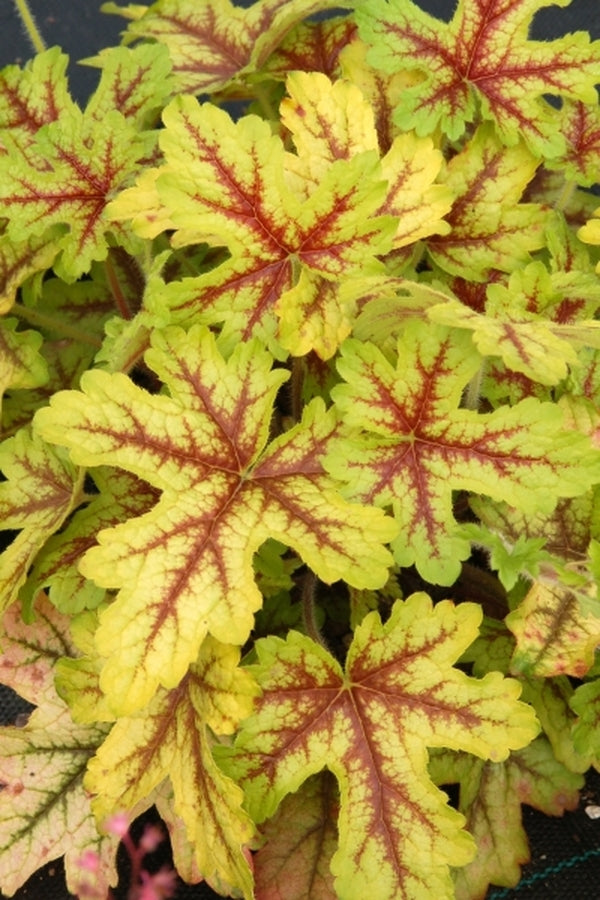
Heucherella 'Alabama Sunrise' PP 19,611
x Heucherella alba 'Pink Frost' (Pink Frost Foamy Bells)
x Heucherella 'Pink Frost' from Charles and Martha Oliver has apple green foliage that is overlain with silver between the veins. The tiny flowers resembling those of coral bells are a uniquely bicolored pink and white! (Hardiness Zone 3-8)
x Heucherella alba 'Rosalie' (Rosalie Foamy Bells)
From Canada, comes this cross of Heuchera x brizoides x Tiarella wherryi. x Heucherella 'Rosalie' has typical green, heuchera-like foliage with heavy red veining toward the center of the leaf. Beginning in spring, the 1' tall x 1' wide clumps are topped with spikes of soft pink flowers. (Hardiness Zone 4-9)
x Heucherella alba 'White Blush' (White Blush Foamy Bells)
Here is another bi-generic hybrid between Heuchera and tiarella from the Olivers. The flowers of x Heucherella 'White Blush' are white with an occasional touch of pale pink. The foliage is apple green with a heavy overlay of silver between the veins. (Hardiness Zone 3-8)
x Heucherella 'Birthday Cake' PP 16,158 (Birthday Cake Foamy Bells)
This unique selection of the bigeneric hybrid (now constitutionally legal in Massachusetts) makes a vigorous 8" mound of deeply lobed, chocolate brown foliage, topped in late spring with a stunning display of creamy white flowers on spikes that extend 6" above the foliage...quite a sight! (Hardiness Zone 4-8a)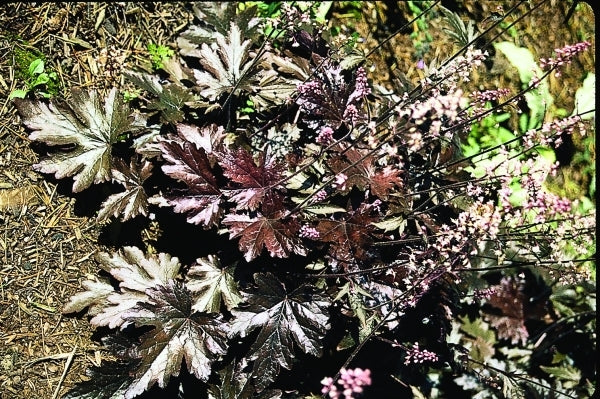
Heucherella 'Burnished Bronze' PP 12159
x Heucherella 'Burnished Bronze' PP 12,159 (Burnished Bronze Foamy Bells)
x Heucherella 'Burnished Bronze' has large lacy leaves of dark chocolate bronze. The 18" stalks of tiny beige flowers top the 1' tall x 1' wide clump in mid-spring...great when used in mass in the woodland garden! (Hardiness Zone 4-8a)
x Heucherella 'Crimson Clouds' (Crimson Clouds Foamy Bells)
This vigorous Heims hybrid is very fuzzy...but then, so is Heims. It is known, however, for its dazzling spikes of crimson flowers in late spring. The foliage is green with very light silver veining. A mass of these in flower in the woodland garden is an unbelievable sight! (Hardiness Zone 4-8)
x Heucherella 'Dayglow Pink' PP 12,164 (Dayglow Pink Foamy Bells)
This foamy bells hybrid is a breakthrough combining the fabulous color of Heuchera sanguinea (pink) with the form and flowering of tiarella. This splendid 8" tall clump is composed of tiarella-like green leaves, each with a dark purple-veined center pattern. Atop the clump in late spring are dozens of dark rosy pink flower spires. (Hardiness Zone 4-8)
x Heucherella ‘Golden Zebra’ PPAF (Golden Zebra Foamy Bells)
x Heucherella ‘Golden Zebra’ is the latest in a line of cool foamy bells from the breeders at Terra Nova. x Heucherella ‘Golden Zebra’ makes a 10" tall by 15" wide clump of bright gold, deeply lobed foliage with a prominent black pattern in the middle of each leaf. The evergreen clumps are topped with 18" tall bottlebrush-like spikes of tiny white flowers in spring. (Hardiness Zone 4-8)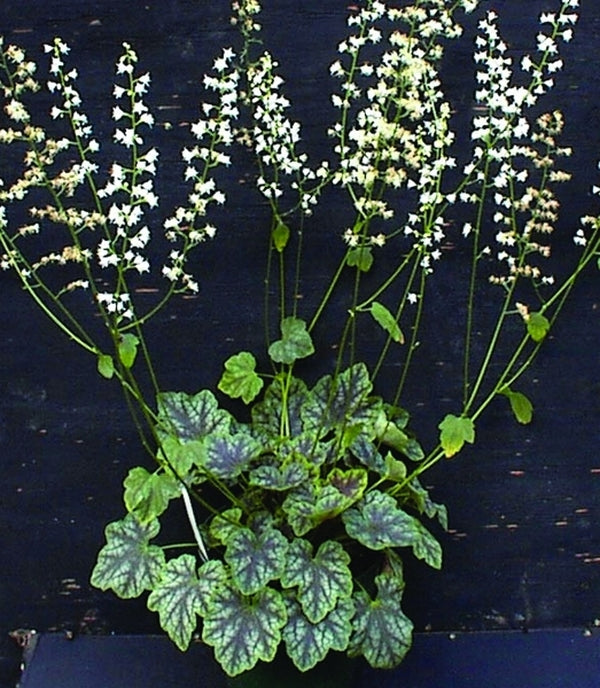
Heucherella 'Heart of Darkness' PP 14,489, PVR
x Heucherella 'Heart of Darkness' PP 14,489 (Heart of Darkness Foamy Bells)
This Charles Oliver hybrid of Heuchera x tiarella has produced one of the best hybrids that we have seen. The green leaves are overlaid first with silver, and then with a wide black pattern that follows the leaf veins. In late spring, the 1' tall clumps are topped with dramatic 18" tall branched spikes of pure white flowers...a great addition to the well-drained woodland garden. (Hardiness Zone 4-8)
x Heucherella 'Kimono' PP 12,154 (Kimono Foamy Bells)
When I visited the Terra Nova breeding facility, seeing this plant was the highlight of my trip. Certainly the most stunning of the Heuchera x tiarella hybrids, x Heucherella 'Kimono' makes a spectacular 20" tall by 3' wide clump with giant 7-9" long pointed green leaves, each adorned with a wide black stripe down the center. Resembling a tiarella on steroids, the plants are topped in April and early May with white tiarella-like bottlebrush flowers. (Hardiness Zone 4-8a)
x Heucherella 'Party Time' PP 16,181 (Party Time Foamy Bells)
x Heucherella 'Party Time' makes a 1' wide clump of deeply lobed green leaves, each with brown-black veining and a silvery overlay. In late spring, the 9" tall clumps are topped with showy, 18" spikes of pink and white flowers...a real show. (Hardiness Zone 4-8a)
x Heucherella 'Quicksilver' PP 11,081 (Quicksilver Foamy Bells)
This introduction from the Olivers captured a blue ribbon in the 1997 Royal Horticulture Society Exposition in Holland, x Heucherella 'Quicksilver' has typical heuchera-shaped leaves of metallic silver, highlighted by a darker bronze veining. Above the 1' tall foliage in May, are clouds of large pink flowers that fade to white...superb for a mass planting in the woodland garden. (Hardiness Zone 4-8)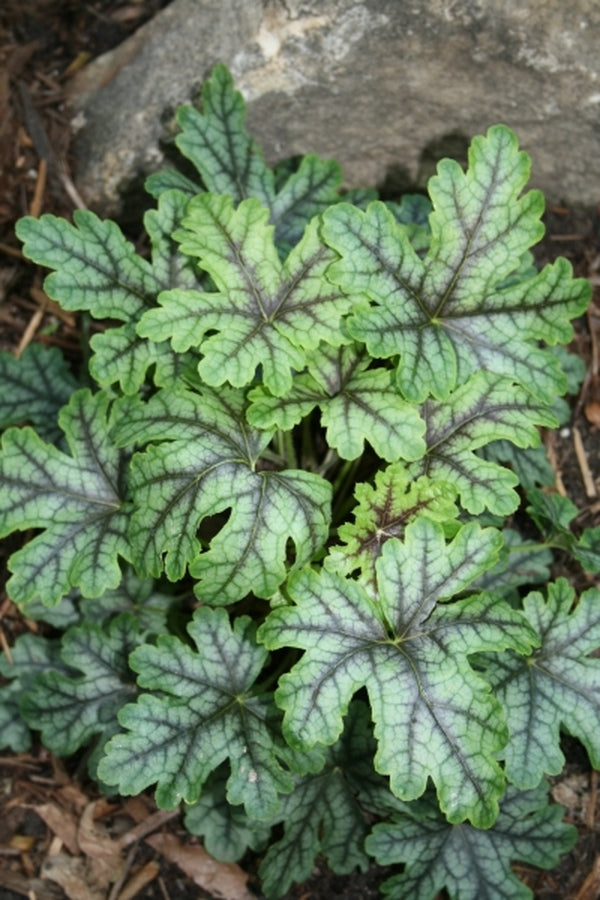
Heucherella 'Tapestry' PP21,150
x Heucherella 'Silver Streak' (Silver Streak Foamy Bells)
This hybrid from Dan Heims is truly one of the most distinctive members of this group of foamy bells. In shape, the leaves resemble a very cut leaf tiarella...in color, a heuchera. The leaves are light lavender and are highlighted by deep maroon veins. In late April through June, the 1' tall clumps are topped with tiny sprays of pink flowers held 6" above the foliage...great for a mass planting in the woodland garden. (Hardiness Zone 4-9)
x Heucherella 'Snow White' (Snow White Foamy Bells)
From the garden of the Olivers, comes the first pure white-flowered x heucherella. The compact 18" tall mound of heuchera-like green leaves with a nice silver overlay between the veins, gives rise to sprays of tiny white flowers. (Hardiness Zone 5-9)
x Heucherella 'Stoplight' PP 16,835 (Stoplight Foamy Bells)
x Heucherella 'Stoplight' is similar to x Heucherella 'Sunspot' but is slightly more vigorous and has a larger patch of red in the center of the bright yellow leaf. The 6" tall x 1' wide evergreen clumps, which are brightest in the spring, are topped in late spring with bottlebrush-like spikes of white flowers. (Hardiness Zone 4-8a)
x Heucherella 'Sunspot' PP 14,825 (Sunspot Foamy Bells)
This amazing Terra Nova introduction makes an 8" tall x 18" wide clump of golden foliage highlighted by a heart-stopping central pattern of red veins. In late spring, the brilliant golden clump is topped with red stems supporting the fluorescent pink flower spikes. (Hardiness Zone 5-8a)
x Heucherella 'Tapestry' PP 21,150 (Tapestry Foamy Bells)
The deeply-lobed tricolor leaves are olive green toward the edge, silver in the center, and dark purple along the veins which radiate out into the silver portion. As the weather cools in fall and early spring, the purple veins intensify and expand to cover more of the leaf surface. The leaves compose the 7" tall by 16" wide clump, topped with 12" stalks of tiny, light pink flowers in early June (NC). (Hardiness Zone 4-8)
x Heucherella 'Viking Ship' PP 12,029 (Viking Ship Foamy Bells)
The silvery leaves are highlighted by a network of olive-green veins. In cool weather the leaves act really bizarre as the midsection of the leaf disappears...leaving the leaf tip connected to the base by a sturdy thread (you've got to see this!) The 1' wide clump is topped in mid-spring with stunning flower stalks of tiny, medium-pink five-petalled flowers. Between each of the petals is an additional smaller pale-pink petal giving the plant a unique two-toned appearance. (Hardiness Zone 5-9)
Conclusion
Heuchera (Coral Bells) and x Heucherella (Foamy Bells) are alluring hardy perennial plants for any garden. Their exotic foliage will fascinate you and their dainty flowers will delight you. Plant them in your garden, then sit back, and enjoy the show. You may be asking yourself, "What is the best heuchera, x heucherella, and tiarella for me?" In North Carolina, your best bet is to select a garden hybrid that has been bred for heat tolerance. Whichever one of these native charmers that you choose, you will get a winner.
Heuchera References
Bloom, A., (1992), Classic Coralbells, Horticulture Magazine, May issue, Pp.66-69.
Cox, J. (2002), 'Bridget Bloom' Foamy Bells, in Perennial Allstars: The 150 Best Perennials for Great-Looking Touble-Free Gardens, Rodale Books, Pg. 172.
Han, S. S., (1998), Postharvest handling of cut Heuchera sanguinea Engelm. Flowers : Effects of sucrose and silver thiosulfate, ASHS Southern Region Annual Meeting, 33(4), pp. 590-606
Hawke, R. G., (2003), Plant Evaluation Notes: An Evaluation Study of Coral Bells, Chicago Botanic Garden.
Heims, D. (1999), Heuchera Heyday, American Nurseryman, March 1 issue, Pp. 30-34.
Oliver, C., and Oliver, M. (2006), Heuchera, Tiarella, and Heucherella: A gardeners guide, B T Batsford Press.
Pilon, P. (2002), Heuchera 'Fireworks' Coral Bells, Greenhouse Product News, 12(9),
Rice, G., (2009), Mining the potential of Shade-loving Natives, The American Gardener, March/April issue, Pp. 24-28.

